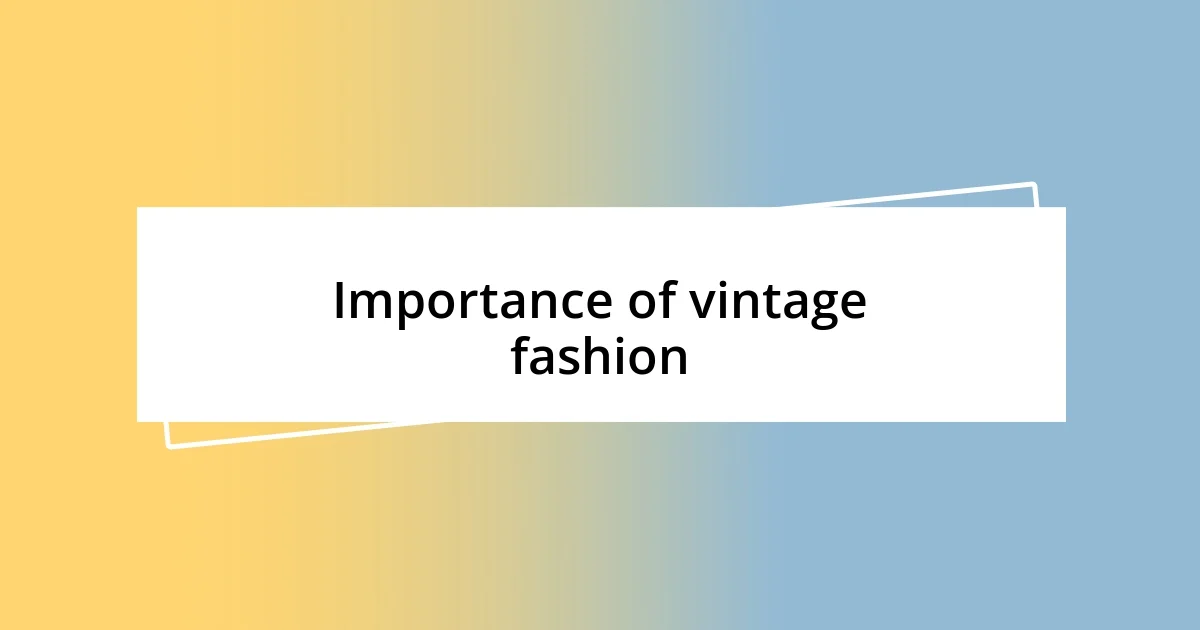Key takeaways:
- Vintage clothing transcends aesthetics, serving as a connection to history, culture, and social movements of past eras.
- Embracing vintage fashion promotes sustainability, unique personal style, and a deeper appreciation for fashion history.
- Proper care for vintage items, including gentle cleaning, appropriate storage, and regular inspections, ensures their longevity and preservation.

Understanding vintage clothing styles
Understanding vintage clothing styles goes beyond just aesthetics; it’s about embracing a story and a history. I remember the first time I slipped into a vintage 1970s floral dress at a thrift store, feeling its soft fabric, and I thought, “Who wore this before me?” It’s fascinating to think that each garment carries memories, a history that ties us to different eras and the individuals who lived in them.
When we talk about vintage clothing, it’s essential to consider the different styles that define various decades. For instance, the sharp lines and tailored looks of the 1940s exude sophistication, while the flowing silhouettes of the 1970s evoke a sense of freedom and bohemian spirit. I often find myself pondering how these styles reflect the social movements of their time—think of how the flapper dresses of the 1920s symbolized women’s liberation. Doesn’t that make you appreciate not just the look, but the cultural significance behind these pieces?
As I delve deeper into understanding these styles, I can’t help but feel a connection to the past—like stepping into someone else’s shoes, even if just for a moment. Every vintage piece I discover feels like a treasure, a tangible link to a time and place that once thrived. And isn’t it intriguing how fashion has this cyclical nature? What was once out of style often comes back, reminding us that there’s always room for nostalgia in our wardrobes.

Importance of vintage fashion
Vintage fashion holds an importance that transcends mere trends; it is like an invitation to connect with history. I distinctly remember attending a retro fashion show, where each model showcased beautiful garments from previous decades. I felt a surge of excitement as I watched the vibrant colors and unique patterns come alive on the runway. It struck me that these pieces not only illustrate the artistry of different eras but also represent a rebellion against the fast-fashion culture we see today.
Consider the benefits of embracing vintage fashion:
– Sustainability: Investing in vintage clothing reduces waste and promotes recycling, a crucial step for our planet.
– Unique Expression: Each vintage piece is one-of-a-kind, allowing for personal style that stands out in a sea of sameness.
– Cultural Appreciation: Wearing vintage adds depth to your wardrobe and showcases an appreciation for fashion history.
These aspects deepen the significance of vintage fashion in our lives and broaden our understanding of personal style. With each piece we choose, we tell a story that resonates beyond our own individual narratives.

Researching vintage fashion eras
Researching vintage fashion eras can be a delightful journey into the past. I often find myself getting lost in online archives or vintage magazines, where each page turn reveals styles I never knew existed. One time, I stumbled upon a collection of 1960s mod fashion illustrations, and I was captivated by the bold patterns and colors. It felt like stepping into a time capsule, offering a glimpse of the vibrant cultural shifts of that decade.
As I delved deeper, I noticed that each era not only reflects design preferences but also societal changes. For example, the shift from the conservative silhouettes of the 1950s to the more liberated styles of the 1970s mirrors the evolving attitudes towards gender and freedom. It’s hard not to feel a connection to those who boldly donned these outfits, representing a changing world. Have you ever tried to visualize the world as it was when these clothes were made? I find it sparks my imagination and adds layers to the clothes I wear.
The thrill of discovering distinct vintage styles often drives me to explore different resources. I reference books about fashion history and frequently visit local vintage shops, where I can talk to shop owners about their finds. At one small boutique, I bumped into a lovely elderly lady who shared stories of her own experiences wearing fashion from the 1940s. Those snippets of personal history not only enrich my understanding but also help me appreciate how each garment represents so much more than threads and fabrics.
| Era | Characteristics |
|---|---|
| 1920s | Flapper dresses, shorter hemlines, loose silhouettes |
| 1940s | Tailored looks, structured shoulders, war-time practicality |
| 1960s | Mod styles, bold patterns, innovative fabrics |
| 1970s | Bohemian influences, flowing shapes, vibrant colors |

Finding reliable vintage clothing sources
Finding reliable vintage clothing sources can feel like a treasure hunt, and, honestly, it’s one of my favorite parts of the process. I remember visiting a tiny thrift store, tucked away in a quiet neighborhood, and finding an exquisite 1970s maxi dress that had clearly been loved before. It was a sheer stroke of luck coupled with a little persistence; sometimes, the hidden gems are just waiting for you to discover them.
I often recommend exploring online platforms like Etsy or Depop, where independent sellers showcase curated collections. On one occasion, I purchased a vintage denim jacket from a seller who included a handwritten note detailing the jacket’s history—it made my purchase feel even more special. Have you ever had a similar experience? Connecting with the story behind a piece can truly deepen your appreciation for vintage fashion, reminding us that every garment has its own unique narrative.
Attending vintage markets and fairs has also been a game changer for me. I recall my excitement at a weekend market when I stumbled upon a stall filled with retro accessories. The vendor, an older gentleman, shared stories about the pieces, which sparked my curiosity and made every item feel alive. Engaging directly with sellers not only supports local businesses but also builds a sense of community among fellow vintage lovers. What better way to find reliable sources than through passionate individuals who cherish the history behind every piece?

Tips for shopping vintage clothing
When it comes to shopping for vintage clothing, patience is key. I remember spending an entire afternoon rifling through racks at a local thrift shop only to find a stunning 1950s dress buried beneath a pile of mundane items. That moment turned into a mini celebration; it felt like winning the lottery! Don’t you think that thrill of discovery makes each find feel more meaningful?
Another tip I’d offer is to try things on, even if they look small on the hanger. Once, I hesitated over a classic 1940s skirt because it looked tiny, but I decided to give it a shot. To my surprise, the high waist and flowing fabric created such a flattering silhouette! Have you ever felt the exhilaration of a piece exceeding your expectations like that? It’s a reminder that vintage sizing often differs, and you might just rock something unexpected.
Lastly, developing a keen eye for quality can transform your shopping experience. I’ve learned to look for well-constructed garments, like those with sturdy seams or quality zippers. One day, I passed on a cute dress with frayed edges and instead chose a timeless 1960s blouse that was perfectly preserved. In the end, having a few high-quality pieces in my wardrobe beats filling it with items that won’t stand the test of time—don’t you agree?

Incorporating vintage into modern wardrobe
Incorporating vintage pieces into your modern wardrobe can be more rewarding than you might expect. I remember the first time I added a vintage plaid blazer to my outfit; it felt like taking a step back in time while maintaining a modern edge. Pairing that blazer with a simple white tee and skinny jeans turned a casual look into something memorable. Doesn’t it feel great when a small addition can elevate your entire ensemble?
Mixing vintage with contemporary styles is all about balance. One day, I decided to wear a vibrant 1980s statement skirt with a sleek, modern crop top. The bold clash of eras created a unique aesthetic that turned heads wherever I went. Have you ever found yourself drawn to the striking contrast between the classic and the trendy? It’s an exhilarating way to express individuality.
Accessories are another fantastic avenue for blending vintage with modern flair. I adore adding vintage brooches or scarves to my outfits—they offer a touch of nostalgia without overwhelming a look. Just last week, I pinned a delicate vintage brooch onto my backpack, and it sparked a delightful conversation with a stranger. Isn’t it fascinating how a single accessory can bridge generations and ignite connections?

Caring for vintage clothing items
Caring for vintage clothing requires a bit of love and attention. I remember my first vintage purchase—an exquisite 1960s dress. Initially, I was overjoyed, but I quickly learned that the fabric required gentle care. Using a mild detergent and cold water for hand washing became my routine. Have you ever been nervous about ruining a cherished piece? Learning to treat vintage items with care not only preserves their beauty but also ensures they can be enjoyed for years to come.
Storage is another crucial aspect of preserving these treasures. After I acquired a delicate lace blouse, I made a conscious decision to store it in a breathable garment bag rather than my usual closet space. This simple change protected it from dust and potential damage. I can’t emphasize enough how vital it is to keep vintage pieces away from harsh sunlight and damp environments. Have you thought about how temperature and light can affect your wardrobe? It’s truly eye-opening to realize that environmental factors can significantly influence the lifespan of your beloved clothes.
Lastly, regular inspections can help catch minor problems before they escalate. I’ve developed a habit of checking my vintage garments for loose threads or small stains after each wear. Recently, I found a tiny snag on a favorite cardigan and promptly mended it, feeling accomplished in the process. Isn’t it satisfying to do a little maintenance on something you love? Taking these extra steps ensures that your vintage collection remains not just wearable but cherished for generations.














